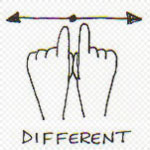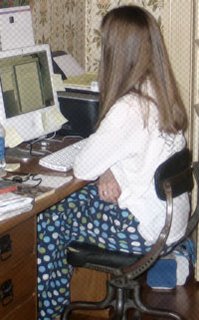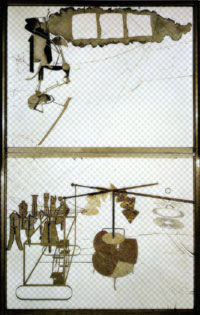I DISAGREE
 We live in a nation of fools – perhaps a world of fools. We – collectively, though not necessarily individually – have forgotten the value of these words: I disagree. I love these words and what they stand for. To disagree is one of the most remarkable capacities that we as beings have been endowed with, but an ability we use far too little. Here, perhaps, I should clarify a little, explain what I mean.
We live in a nation of fools – perhaps a world of fools. We – collectively, though not necessarily individually – have forgotten the value of these words: I disagree. I love these words and what they stand for. To disagree is one of the most remarkable capacities that we as beings have been endowed with, but an ability we use far too little. Here, perhaps, I should clarify a little, explain what I mean.Disagreement and opposition are not the same thing, nor is disagreement the same as argument, or criticism. According to the Oxford American Dictionary – i.e. my dictionary widget – to disagree is to “have or express a different opinion.” It requires that the person who disagrees listens, or has listened, to what someone else has said, understands it, and formulates – and I would say ideally expresses – an alternate opinion. To disagree at first demands participation, involvement with the other; it is a collaborative activity that breeds coexistence.
But before one even reaches the process of disagreement – listening, considering, and responding – one must participate in a more fundamental activity; one must be willing to stand up as an individual and be held accountable for one’s thoughts, to separate from the common discourse and be right here, right now as a person. Disagreement can be general, but the statement “I disagree” is always here and now: this moment, this issue, this voice.
Further, to disagree means that one must also consider the possibility of agreement, to expose oneself to the risk of having one’s mind changed. Opposition, argument, and criticism are easy. Opposition is a simply bodily act: I stand here before you and bar your way; none shall pass. Argument needs no reciprocity – lawyers do not speak to each other to argue their case; countless arguments are made to justify one’s action rather than discuss them. Criticism perpetually adopts the trope of neutrality – objectivity – rather than suffer the possibility of disagreement.
Disagreement is personally dangerous just as it is potentially meaningful. One disagrees and thus opens their opinions up for disagreement, and thus discussion. To disagree is to disagree with something, some other opinion or belief. It must adopt a commonality, a space for discussion, a set of ideas that are under consideration – at least provisionally. Disagreement sets up a calculus, a set of methods and reasoning by which to attempt to understand, a calculus that must at some level be shared to allow disagreement to occur. It is unlike argument, which allows parallel statements that share no ground, in fact that may be entirely unrelated. Disagreement demands relation, and this is why I love these words – I disagree.
I disagree with a lot of things: When I hear that art is primarily about aesthetics, I disagree; when I hear that the current administration is doing a good job at governing, I disagree; when someone says that Punk is coming back, I disagree. In fact, I am probably an extremely disagreeable person, or at least I disagree a lot. I don’t know if that is necessarily a good attribute, but it is one I wish I found more often.
There are too many topics we avoid – the ones that are too difficult – hence there is too little understanding. We – again collectively speaking – are afraid of disagreeing, but when we try to allow ourselves the possibility, we simply lapse into argument, opposition, and criticism. I too often find myself weary of being politic, of fearing disagreement. I wonder what else I really have to offer. Isn’t this – the ability to disagree – the purpose of having a mind and of having words? I think of disagreeing as a responsibility, an obligation that comes from listening; it is that willingness to participate in the discussion. Disagreement concedes the possibility of agreement – whether immediate or gained through disagreement, discussion, and eventual resolution. Disagreement is an act of faith that discussion can occur; it is a gift consisting of examination, reflection, and consideration.
I want to understand the world around me; I want to find a way for it for make sense to me and, ideally, for others. Even more, I want it to work: that is, for the greatest number of people to have the greatest amount of contentment. I believe the first step in these processes is to stand up and assume the risks of disagreement: whether it be risking the disagreement of others, or assuming the possibility of agreeing or disagreeing oneself.
Perhaps I am watching too many Sunday morning news shows, reading a few too many Op-Ed pieces online, hitting too many twenty-four hours news sources. Perhaps I just have too much time to think and write these days. Maybe there is just too much to disagree with and I have yet to reconfigure my means of outlet properly. Whatever the reason, this phrase – I disagree – has been weighing heavily on my mind lately; it seems to be the dominant expression rattling around in my skull. It seems such a significant, meaningful act, but one that seems most neglected when I look around. But then again it may have nothing to do with anything out there. Though someday I would love to wake up, read the news, and find people engaging in meaningful disagreement – or better yet agreement.
































